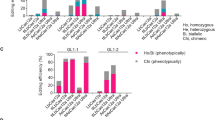Abstract
Existing transgenic RNAi resources in Drosophila melanogaster based on long double-stranded hairpin RNAs are powerful tools for functional studies, but they are ineffective in gene knockdown during oogenesis, an important model system for the study of many biological questions. We show that shRNAs, modeled on an endogenous microRNA, are extremely effective at silencing gene expression during oogenesis. We also describe our progress toward building a genome-wide shRNA resource.


Similar content being viewed by others
Accession codes
References
Perrimon, N., Ni, J.Q. & Perkins, L. Cold Spring Harb. Perspect. Biol. 2, a003640 (2010).
Czech, B. & Hannon, G.J. Nat. Rev. Genet. 12, 19–31 (2011).
Haley, B., Hendrix, D., Trang, V. & Levine, M. Dev. Biol. 321, 482–490 (2008).
Chen, C.H. et al. Science 316, 597–600 (2007).
Ni, J.Q. et al. Genetics 182, 1089–1100 (2009).
Petrella, L.N., Smith-Leiker, T. & Cooley, L. Development 134, 703–712 (2007).
Rorth, P. Mech. Dev. 78, 113–118 (1998).
Malone, C.D. & Hannon, G.J. Cold Spring Harb. Symp. Quant. Biol. 74, 225–234 (2009).
Kulkarni, M.M. et al. Nat. Methods 3, 833–838 (2006).
Birmingham, A. et al. Nat. Methods 3, 199–204 (2006).
Dietzl, G. et al. Nature 448, 151–156 (2007).
Vert, J.P., Foveau, N., Lajaunie, C. & Vandenbrouck, Y. BMC Bioinformatics 7, 520 (2006).
Cleary, M.A. et al. Nat. Methods 1, 241–248 (2004).
Erlich, Y. et al. Genome Res. 19, 1243–1253 (2009).
Van Doren, M., Williamson, A.L. & Lehmann, R. Curr. Biol. 8, 243–246 (1998).
Tracey, W.D. Jr. et al. Genetics 154, 273–284 (2000).
Ni, J.Q. et al. Nat. Methods 5, 49–51 (2008).
Perrimon, N., Engstrom, L. & Mahowald, A.P. Genetics 121, 333–352 (1989).
Brennecke, J. et al. Cell 128, 1089–1103 (2007).
Nishida, K.M. et al. EMBO J. 28, 3820–3831 (2009).
Cook, H.A., Koppetsch, B.S., Wu, J. & Theurkauf, W.E. Cell 116, 817–829 (2004).
Vagin, V.V. et al. Science 313, 320–324 (2006).
Czech, B. et al. Nature 453, 798–802 (2008).
Zhou, R. et al. RNA 15, 1886–1895 (2009).
Livak, K.J. & Schmittgen, T.D. Methods 25, 402–408 (2001).
Czech, B. et al. Mol. Cell 36, 445–456 (2009).
Acknowledgements
The design and construction of the first shRNAs were supported in part by the Janelia Farm Visitor Program. We thank G. Rubin, C. Zuker and T. Laverty for their interest and support; R. Hardy and C. Zuker for the data presented in Supplementary Table 2; B. Haley for helpful discussion on shRNAs; L. Cooley (Yale University) for the gift of the MTD-Gal4 line; and Z. Xuan for help with library design. S. Zusman and M. Tworoger of Genetic Services, Inc. generated the transgenic lines. R.Z. is supported by the Leukemia and Lymphoma Society. B.C. is supported by a PhD fellowship from the Boehringer Ingelheim Fonds. This work was supported by two US National Institute of General Medical Sciences R01 grants (GM067761 and GM084947) to N.P., an EU FP7 European Research Council starting grant to J.B. and contributions from the US National Institute of Neurological Disorders and Stroke.
Author information
Authors and Affiliations
Contributions
J.-Q.N., R.Z. and B.C. carried out major experiments; L.-P.L., L.H., D.Y.-Z., H.-S.S., R.B., M.B. and L.A.P. produced the TRiP lines; P.K. performed the luciferase experiments in ovaries; D.H. and J.B. analyzed the piRNA pathway during oogenesis; and G.J.H. and N.P. supervised the project. R.Z., B.C., J.-Q.N., D.H., J.B., G.J.H. and N.P. wrote the manuscript.
Corresponding author
Ethics declarations
Competing interests
The authors declare no competing financial interests.
Supplementary information
Supplementary Text and Figures
Supplementary Figures 1–8, Supplementary Tables 1–3 and Supplementary Notes 1–3 (PDF 1347 kb)
Rights and permissions
About this article
Cite this article
Ni, JQ., Zhou, R., Czech, B. et al. A genome-scale shRNA resource for transgenic RNAi in Drosophila. Nat Methods 8, 405–407 (2011). https://doi.org/10.1038/nmeth.1592
Received:
Accepted:
Published:
Issue Date:
DOI: https://doi.org/10.1038/nmeth.1592
- Springer Nature America, Inc.
This article is cited by
-
Emergence of periodic circumferential actin cables from the anisotropic fusion of actin nanoclusters during tubulogenesis
Nature Communications (2024)
-
Whole transcriptome screening for novel genes involved in meiosis and fertility in Drosophila melanogaster
Scientific Reports (2024)
-
Modeling early germline immunization after horizontal transfer of transposable elements reveals internal piRNA cluster heterogeneity
BMC Biology (2023)
-
The autophagy protein Def8 is altered in Alzheimer's disease and Aβ42-expressing Drosophila brains
Scientific Reports (2023)
-
Pantothenate kinase 2 interacts with PINK1 to regulate mitochondrial quality control via acetyl-CoA metabolism
Nature Communications (2022)





